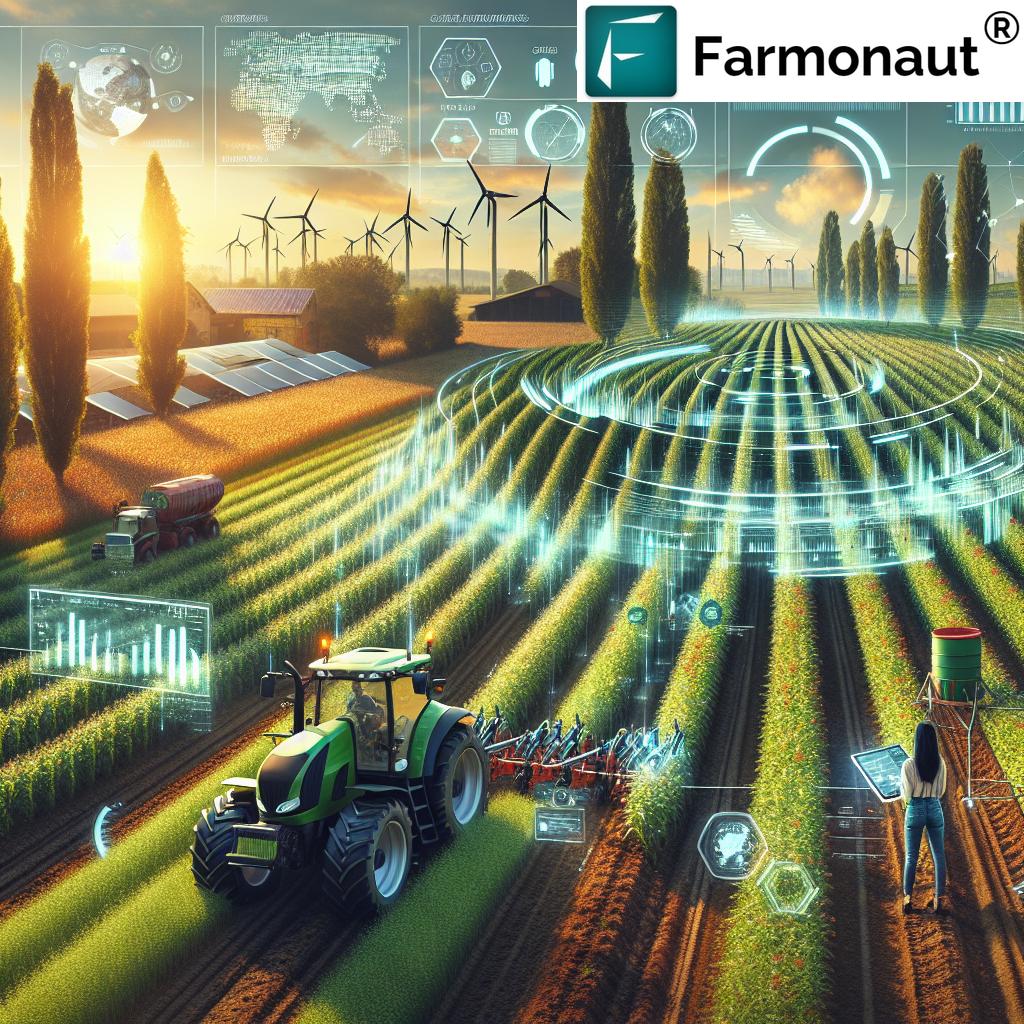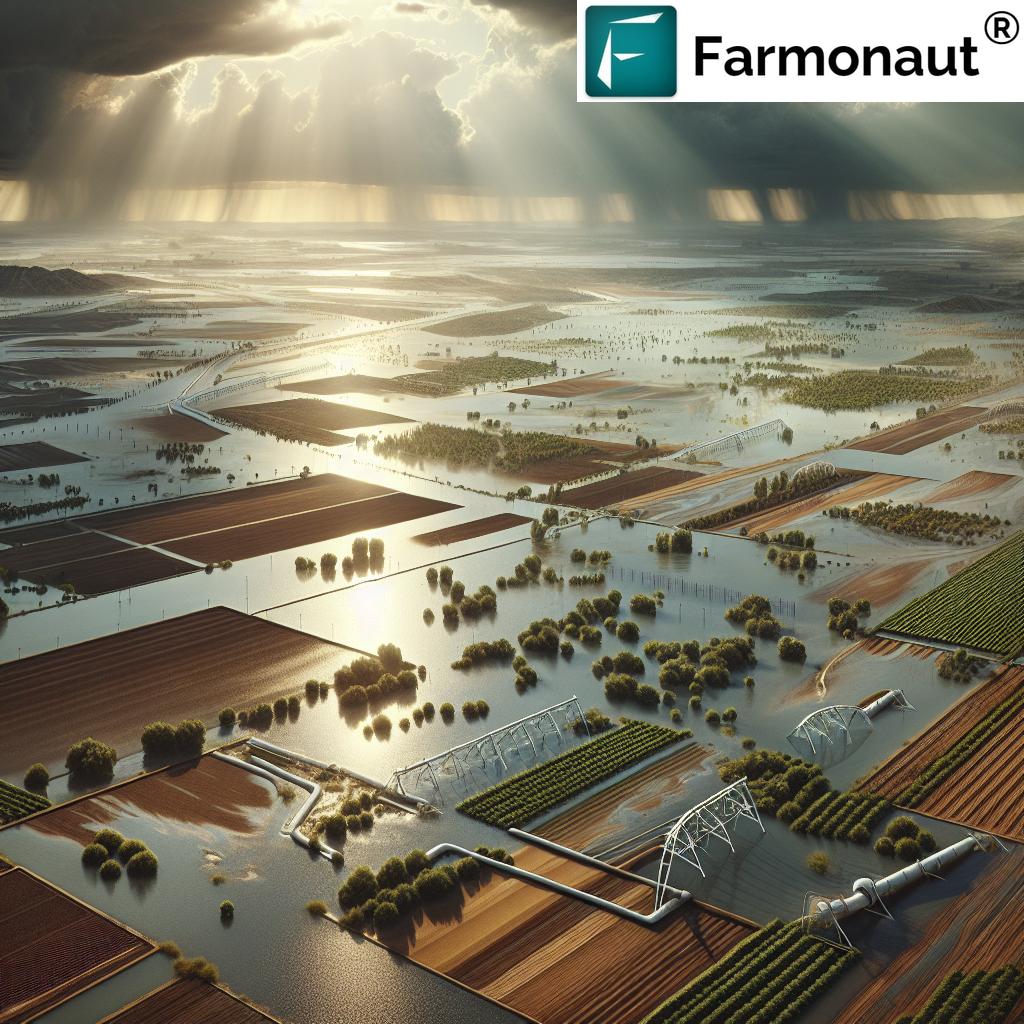Status of Digital Agriculture in 18 Countries: 2025 Insights
“In 2025, over 60% of 18 surveyed countries will implement national digital agriculture strategies.”
“Precision farming adoption rates in Central Asia are projected to rise by 35% between 2023 and 2025.”
Introduction: Digital Agriculture 2025
The status of digital agriculture in 18 countries of Europe and Central Asia in 2025 reveals a dynamic, rapidly evolving region at the nexus of farming technology, policy development, and sustainability. As we move towards a future where agriculture is no longer dictated solely by manual labor and traditional knowledge, the emergence of advanced digital technologies—precision farming, IoT sensors, satellite imaging, AI, and big data analytics—becomes increasingly crucial.
This in-depth analysis presents an authoritative, keyword-rich overview of digital agriculture progress, adoption, and innovation across diverse European and Asian areas, exploring key drivers, challenges, integration strategies, and forward-looking prospects shaping the region’s agricultural landscape in 2025 and beyond.
Overview of Digital Agriculture Across 18 Countries
The status of digital agriculture in 18 countries of Europe and Central Asia demonstrates uneven yet steadily rising digital transformation. Western and northern nations—like Estonia and Lithuania—often set the pace, leveraging outstanding broadband networks, robust policy support, and strong investments in agricultural R&D. Conversely, eastern and central nations, such as Kazakhstan and Uzbekistan, are swiftly catching up through targeted government investment, rural connectivity expansion, and innovation strategies.
This digital trajectory is shaped by varying economic capacities, infrastructure readiness, and evolving policy frameworks. While advanced economies embrace large-scale integration of precision farming and satellite-based monitoring, increasing policy attention in Central Asian countries has spurred greater focus on smallholder inclusion, environmental resilience, and sustainable productivity.
- European Union’s CAP (2023–2027) serves as a catalyst, incentivizing digital tool adoption across member states to optimize inputs, reduce footprints, and support environmental policies.
- Innovative public and private sector partnerships are delivering pilot programs, expanding IoT networks, and improving rural connectivity in the region.
- Adoption remains uneven—driven by differences in broadband access, economic development, and policy implementation.
Key Drivers and Enablers Shaping Digital Agriculture
1. Policy, Investment, and Strategic Planning
Many countries in Europe and Central Asia have integrated digital agriculture into national agricultural development plans, emphasizing innovations for sustainability, climate resilience, and competitiveness. The European Union’s Common Agricultural Policy (CAP) 2023–2027 incentivizes digitalization through sustainable outcomes, economic support, and robust R&D encouragement.
- National Digital Strategies: The presence of official digital agriculture roadmaps now exceeds 60% among the 18 nations surveyed.
- Incentives: Subsidies and grants for technology adoption—especially for precision farming, IoT, drones, and satellite tools.
2. Technological Infrastructure and Connectivity
Access to high-speed internet and broadband networks continues to be the outperforming enabler for digital farming adoption. Countries with superior infrastructure—like Estonia and Lithuania—are leveraging excellent broadband for advanced technologies. In more rural and remote areas of Central Asia and Eastern Europe, substantial investments aim to bridge the connectivity gap, thereby improving access for all farm sizes.
3. Technology Adoption and Integration
Modern agriculture systems increasingly integrate GPS-enabled machinery, automated irrigation controls, remote sensors, satellites, and drones. Satellite crop monitoring platforms and precision agriculture software significantly optimize resource efficiency, disease forecasting, and field-level insights.
- Remote Sensing: Satellite-based imaging and field mapping to monitor crop health, optimize input use, and support decision-making.
- IoT Sensors: Real-time data on soil, weather, and inputs across the farm landscape—crucial for precision farming.
- Drones: Used for aerial imaging, crop scouting, and monitoring efficiency; scalability is improving with new regulations.
- AI-Based Advisory Systems: Decision support for yield forecasting, resource planning, and risk management.
4. Education, Capacity Building, and Extension Services
Digital adoption is underpinned by robust collaborative programs that boost farmer digital literacy. Enhanced extension services, knowledge-sharing events, and farmer training—often led by NGOs, international organizations, and academic institutes—ensure smallholders are included in the digital wave.
Comparative Table: Digital Agriculture Status by Country (2025)
The following comparative table, “Digital Agriculture Status by Country (2025)”, offers a comprehensive glance at the status of digital agriculture in 18 countries of Europe and Central Asia. It evaluates core digital farming indicators: estimated digital agriculture index, adopted technologies (IoT, AI, Drones, Satellite), policy support level, principal challenges, and innovation outlook for 2025. This layout ensures you can quickly benchmark progress, opportunities, and hurdles across the region.
| Country Name | Digital Agriculture Index (2025 est.) |
IoT | AI | Drones | Satellite | Policy Support Level | Main Challenges | 2025 Innovation Outlook |
|---|---|---|---|---|---|---|---|---|
| Poland | 8.2 / 10 | ✔️ | ✔️ | ✔️ | ✔️ | High | Workforce skills, small farm digital gap | Positive 👍 |
| Estonia | 8.1 / 10 | ✔️ | ✔️ | ✔️ | ✔️ | High | Smallholder outreach | Positive 👍 |
| Lithuania | 7.8 / 10 | ✔️ | ✔️ | ✔️ | ✔️ | High | Rural broadband, cost of adoption | Positive 👍 |
| Ukraine | 7.2 / 10 | ✔️ | ✔️ | ✔️ | ✔️ | Medium | Infrastructure, security risks | Neutral 😐 |
| Hungary | 7.6 / 10 | ✔️ | ✔️ | ✔️ | ✔️ | High | Economic disparities, digital literacy | Positive 👍 |
| Romania | 7.1 / 10 | ✔️ | ✔️ | ✔️ | ✔️ | Medium | Rural digital divide, investment | Positive 👍 |
| Kazakhstan | 6.3 / 10 | ✔️ | ✔️ | ✔️ | Medium | Rural connectivity, cost of tech | Positive 👍 | |
| Uzbekistan | 5.9 / 10 | ✔️ | ✔️ | ✔️ | Medium | Infrastructure, education | Positive 👍 | |
| Georgia | 6.4 / 10 | ✔️ | ✔️ | ✔️ | Medium | Capital, scale of farms | Positive 👍 | |
| Bulgaria | 7.0 / 10 | ✔️ | ✔️ | ✔️ | Medium | Fragmented land, rural digital gap | Neutral 😐 | |
| Serbia | 6.7 / 10 | ✔️ | ✔️ | Medium | Outreach, investment | Positive 👍 | ||
| Moldova | 5.8 / 10 | ✔️ | ✔️ | Low | Funding, access to tech | Neutral 😐 | ||
| Kyrgyzstan | 5.6 / 10 | ✔️ | ✔️ | Low | Internet, skilled staff | Positive 👍 | ||
| Slovakia | 7.3 / 10 | ✔️ | ✔️ | ✔️ | High | Farm structure, adoption costs | Positive 👍 | |
| Czech Republic | 7.7 / 10 | ✔️ | ✔️ | ✔️ | ✔️ | High | Policy harmonization | Positive 👍 |
| Turkey | 6.7 / 10 | ✔️ | ✔️ | ✔️ | Medium | Farm size, regional disparity | Positive 👍 | |
| Latvia | 7.0 / 10 | ✔️ | ✔️ | ✔️ | High | Cost, aging farmers | Neutral 😐 | |
| Croatia | 6.9 / 10 | ✔️ | ✔️ | ✔️ | Medium | Fragmented farms | Positive 👍 |
Integrating Advanced Technologies in Digital Agriculture
Digital transformation in agriculture is accelerating in 2025, powered by IoT, AI, drone sensors, satellite imaging, and big data analytics. The region’s future-proof agriculture relies on the integration of these advanced technologies to optimize every aspect of farm and resource management.
- IoT sensors provide instant soil, temperature, and crop-status data—enabling farmers to make real-time, data-driven decisions.
- Satellite imaging supports wide-area monitoring, predicting crop health and yield while optimizing irrigation and inputs.
- Large Scale Farm Management platforms empower agricultural enterprises to oversee vast field networks efficiently. These digital tools leverage satellite, mapping, and analytics for streamlined operations.
- Drones are used for aerial surveying, application of agro-inputs, and high-resolution imaging—transforming precision agriculture practices across the landscape.
- AI-powered analytics and advisory systems such as JEEVN AI—offer proactive crop, water, and pest management recommendations.
Access real-time digital agriculture intelligence and satellite services via Farmonaut’s web and mobile apps for all your field monitoring or resource management needs.
Policy, Investments, and Infrastructure in European & Central Asian Agriculture
Policy Support and Innovation Programs
Robust policy frameworks serve as essential foundations for the upward trajectory of digital integration in agriculture. The implementation of national digital strategies, alliance with EU mandates, and the launch of dedicated funding mechanisms empower rapid technology adoption.
- Subsidies for precision farming equipment, incentives for IoT and drone adoption, and grants for smart irrigation systems are now widespread.
- Programs emphasize inclusivity, targeting both large agricultural enterprises and smallholder farmers through education and infrastructure upgrades.
- Cross-sectoral innovation is promoted, linking climate, energy, and digital agriculture policy under strategic national plans.
Infrastructure Readiness: Closing the Digital Divide
Connectivity remains pivotal. The rollout of 5G networks, expansion of rural broadband, and satellite-based connectivity projects are “levelling the field” for digital agriculture access across regions.
- In Estonia and Lithuania, high rural internet coverage accelerates adoption of IoT and app-based services.
- Central Asian countries, like Kazakhstan and Uzbekistan, are scaling connectivity initiatives and digital literacy drives to overcome historic gaps.
- Remote field monitoring, crop data analytics, and digital advisory platforms are now increasingly available to even remote farmers.
- Carbon Footprinting solutions provide a digital path to sustainable practices, helping rural and large-scale farms in the region comply with environmental policies and optimize energy/resource use.
Challenges and Opportunities: Regional Insights for 2025
Despite remarkable progress, a range of challenges still impede full digital integration across the region’s diverse agricultural areas, often delineated along economic, technological, and institutional lines.
Key Challenges:
- Rural connectivity—inconsistent broadband coverage and digital infrastructure gap in Central Asia and Eastern Europe.
- High upfront costs—acquiring IoT sensors, drones, and precision equipment remains expensive for small and medium farms.
- Workforce skills shortage—digital literacy and technical expertise lag behind the technological advancements.
- Data privacy & regulation fragmentation—lack of harmonized frameworks hinders data-driven solutions and cross-border sharing.
- Smallholder exclusion—risk of digital divide as larger farms adopt faster than smallholders in some areas.
Opportunities in 2025:
- 5G & Satellite Connectivity—set to bridge remote area gaps, increase data exchange and real-time monitoring.
- Policy Synchronization—regional networks supporting harmonized standards across borders (see: Eastern Europe and Central Asia Agriculture Innovation Network).
- AI and Blockchain Adoption—driving transparency, traceability, and advanced advisory.
- Satellite-based Product Traceability—enables all sizes of farms and ag-businesses to certify origin, process, and authenticity, helping build market trust and combat fraud.
Affordable Subscriptions for Scalable Digital Agriculture
Regional Cooperation and 2025 Outlook for Digital Agriculture
Looking forward to 2025 and beyond, digital agriculture in Europe and Central Asia is characterized by increased regional cooperation, harmonized digital policy frameworks, and technology transfer programs that put innovation and sustainability at the forefront.
- Knowledge sharing platforms—such as regional innovation networks—enable collective problem-solving and technology learning.
- Policy support—increasingly aligned with climate adaptation, food security, and rural development goals.
- Enhanced digital services—such as satellite-based crop loan and insurance verification—are streamlining access to financial services and risk mitigation for farmers.
- Integration of AI analytics, big data, and blockchain-based traceability will transform operational transparency and efficiency across the agricultural value chain.
‘Agricultura Digital Brasil’: Global Comparison with Europe & Central Asia
“Agricultura digital brasil” offers key insights for the digital transition currently underway in Europe and Central Asia. The Brazilian case demonstrates both opportunities and hurdles of deploying digital technologies across vast and ecologically diverse agricultural landscapes.
- Brazil’s extensive IoT, drone, and satellite imaging networks have enabled large-scale remote monitoring of diverse agroecological regions (from the Amazon to the Cerrado).
- The broad commercialization of digital tools, led by a strong private sector, ensures rapid scalability across farm sizes—from smallholders to industrial farms.
- State-run and private digital inclusion programs are addressing rural digital divides, a challenge also faced across Central Asia and Eastern Europe.
- Brazil’s supply chain traceability frameworks leverage blockchain and satellite data—demonstrating how digital certification and origin tracking can be implemented at scale.
Europe and Central Asia can draw on these “agricultura digital brasil” lessons:
- Scaling digital services efficiently, even in remote regions, using satellites and cloud-based platforms.
- Ensuring inclusive access for all farm sizes—smallholders and large enterprises alike.
- Building strong public-private partnerships for tool deployment, knowledge transfer, and market integration.
Farmonaut: Advanced Satellite-Based Solutions in Digital Agriculture
We at Farmonaut are committed to democratizing access to digital agriculture insights for European, Central Asian, and global stakeholders. Our platform integrates satellite imagery, AI, blockchain, and remote sensing for real-time, affordable field and resource monitoring across agriculture and allied sectors.
Farmonaut’s Core Services:
- Satellite-based Monitoring: Multispectral imaging for comprehensive vegetation, soil, and farm asset analysis.
- AI-based Advisory: Proactive crop risk, yield, and input management—anchored in real-time remote sensing.
- Blockchain Traceability: Supply chain authentication for agricultural outputs, enhancing trust and regulatory compliance.
- Fleet and Resource Management: Optimize logistics for large and small farms with live tracking and usage analytics.
- Environmental Impact Monitoring: Track carbon emissions and sustainability outcomes, supporting compliance with modern environmental policies.
You can explore our Satellite API and Developer Documentation to integrate advanced digital agriculture data into any system or workflow.
Our platform’s modular approach means farmers and agribusinesses can scale use from individual smallholder plots to large, diversified agricultural networks. The cloud-based, mobile-responsive system brings smart farm management and predictive analytics within reach for all, regardless of location, size, or digital readiness.
We also help financial institutions with satellite-based crop verification for crop loan and insurance—streamlining agricultural financing, reducing fraud, and improving accessibility.
Frequently Asked Questions: Status of Digital Agriculture in 18 Countries of Europe and Central Asia (2025)
Q1: What does “digital agriculture” mean in the context of Europe and Central Asia for 2025?
Digital agriculture in this context refers to the integration and application of advanced technologies—such as IoT sensors, drones, AI-based advisory, satellite imaging, big data analytics, and blockchain traceability—to farming operations. By 2025, it involves using these tools to optimize productivity, monitor environmental impact, make informed decisions, and streamline the agri-food supply chain across 18 diverse countries in Europe and Central Asia.
Q2: Which countries are leading the digital agriculture transformation in the region?
Nations like Poland, Estonia, Lithuania, Hungary, and the Czech Republic are recognized as digital agriculture leaders by 2025. They are buoyed by strong government policy, advanced broadband infrastructure, and high rates of technology adoption in rural areas.
Q3: What are the most common challenges facing digital agriculture adoption?
Major challenges include uneven rural connectivity, high technology investment costs, lack of digital skills, fragmentation of regulatory frameworks, and the risk of digital exclusion for small-scale or resource-poor farmers.
Q4: How do digital agriculture strategies contribute to climate resilience and sustainability?
By enabling precision input use, environmental impact monitoring, data-driven water/resource management, and carbon footprint tracking, digital agriculture strategies support climate-resilient crop production and sustainable land management—helping European and Central Asian farms meet regulatory and market expectations in 2025 and beyond.
Q5: What unique lessons can European and Central Asian nations learn from ‘agricultura digital brasil’?
Brazil demonstrates the potential of large-scale technology integration, supply chain traceability, and digital inclusion programs to manage both extremely large farms and fragmented smallholder plots across diverse agroecological landscapes.
Q6: How can Farmonaut support digital agriculture adoption in this region?
We provide affordable satellite-driven insights via web and mobile, powering farm monitoring, resource optimization, and environmental compliance. Our platform connects users to real-time analytics, AI-based advisory, blockchain traceability and more, enabling scalable and inclusive digital transformation.
Q7: How do I access Farmonaut’s digital agriculture services or integrate its API?
Use our app (web/browser, Android, iOS) for real-time satellite monitoring or refer to our API and developer docs for integration into custom or enterprise digital agriculture solutions.
Conclusion: Prospects for Digital Agriculture Beyond 2025
The status of digital agriculture in 18 countries of Europe and Central Asia in 2025 demonstrates strong, forward-looking momentum. Despite persistent challenges—such as rural connectivity issues, digital skills gaps, and fragmentation—the landscape is being transformed by inclusive policy, innovation investment, advanced technologies, and collaborative efforts.
The strategic use of satellite services, IoT, drone imaging, AI-powered advisory, and robust traceability frameworks is reshaping food production, resource management, and climate adaptation. Regional cooperation, harmonized digital strategies, and practical lessons from global cases like “agricultura digital brasil” offer powerful roadmaps for inclusive, sustainable, and scalable digital transformation.
Digital agriculture is poised to be the bedrock of a resilient, connected, and progressive future for European and Central Asian agriculture—with the region well-placed to achieve its 2025 food security, economic, and climate goals.
For full-featured, scalable digital agriculture monitoring and AI-driven advisory, visit the Farmonaut Large Scale Farm Management page or discover innovative offerings for forest and plantation advisory.












